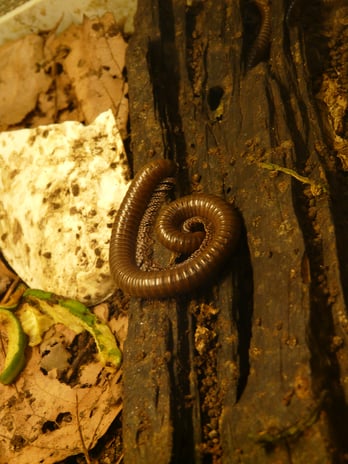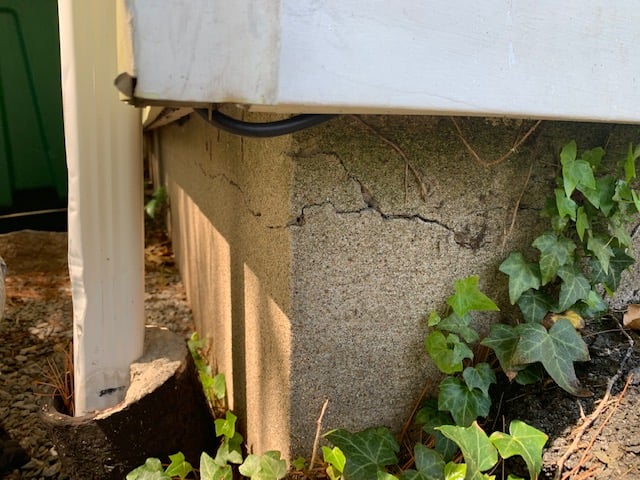Are centipedes and millipedes the same pest? How can I tell centipedes and millipedes apart? These are some of the most frequently asked questions regarding household pests. Millipedes and centipedes are both arthropods that have segmented bodies and a large number of legs. Both insects are commonly found in New Jersey and Pennsylvania, although you're much more likely to see a centipede in your home than a millipede.
What do centipedes and millipedes look like?
The name "millipede" comes from Latin origin, meaning "thousand feet." It's a common misconception that millipedes have 1,000 legs because there have never been any recorded cases of millipedes reaching that amount. Millipedes have between 40-400 pairs of legs depending on the species, of which there about 10,000. Millipedes are slow-moving and tend to curl up into a spiral when disturbed, releasing an unpleasant scent. They’re not as common of a nuisance pest for homeowners in New Jersey and Pennsylvania, but millipedes can be occasional invaders.
Millipedes are typically blackish brown in color and 1-2 inches long. Although they are not actual worms, most people will associate their round body with a worm-like shape. Their natural diet consists of decaying wood, decaying or dead plant matter, and occasionally decomposing animals.

Left: Millipede, Right: Centipede
Centipedes are ugly but useful pests that you can find in your basement or bathroom. They are drawn to dark and moist environments that typically exist within human made structures such as houses and office buildings. Even if they may creep you out, centipedes are useful when it comes to natural pest control. Their natural diet consists of spiders, crickets, ants, cockroaches, silverfish, and other small insects that may be crawling around your basement.
Centipedes have 15-177 body segments, which typically have one pair of legs each. Their color varies, but common house centipedes are yellow and dark brown as shown in the picture above (right). They move very quickly in rapid spurts with their many legs which makes them hard to catch and frightening to encounter. Luckily, both centipedes and millipedes aren’t dangerous.
Do centipedes and millipedes bite?
Centipedes can bite, but there’s a slim chance that it’ll happen to you. They won’t go out of their way to chase you, nor do they feed off of humans. Unless you directly handle a centipede, you won’t be bitten. Millipedes do not bite. Instead of a physical attack, millipedes will curl into a ball and release a stinky stench when they feel threatened. Both centipedes and millipedes are relatively harmless to humans. They will not transmit disease or harm your pets and children. It’s even a good thing to keep a few centipedes around because they eat other insects.
Why are there centipedes and millipedes in my basement?
Small cracks and crevices around the foundation of your home, in addition to open vents, gaps around utility pipes, and torn basement window screens provide a perfect space for centipedes to squeeze in. When living outdoors, centipedes can be found under rocks and bricks, in woodpiles, under mulch, and in leaf litter. Centipedes like moist environments and enter structures such as your basement to seek shelter. Their diet includes insects and spiders, so if there is an infestation of another pest, centipedes may follow. Once they find a suitable environment with food, moisture, shelter, and little foot traffic from humans in areas such as unfinished basements and crawlspaces, centipedes can live. It's not uncommon to find centipedes in other rooms with moisture such as bathrooms and under dishwashers or sinks.

Millipedes prefer to live outdoors, feeding on decaying or dead plant matter. You can find them in flowerbeds, within leaf litter, under mulch, and below other items laying on damp soil. After heavy rains, it's likely that millipedes will be pushed into your home if an entry point exists. Especially, when dry or hot weather creates an uncomfortable environment for millipedes, this is when they may be drawn into your home if you have water damage or humidity in your basement or garage. Millipedes need plant matter to survive, which is not something that's readily available in your home. If you want to remove them, simply vacuum them up as you see them because they will die in 24-48 hours indoors.
How can I prevent centipedes and millipedes from entering my home?
Centipedes and millipedes can be controlled by sealing cracks and crevices that serve as entry points and keeping vegetation and moisture of any sort away from the foundation of your home. Addressing any pest activity in your home begins with prevention. To keep centipedes and millipedes from getting into your home, you can seal cracks and crevices in the foundation, around doors, and basement windows. Ensure that moisture is kept away from the foundation by making sure gutters function correctly and all leaks are repaired. Centipedes and millipedes aren't very big, so they don't need a large hole to enter.

Finding millipedes in your home could be a sign of water damage so you will want to examine your home regularly and immediately repair problem spots. Lastly, you can keep plant-life, stones, boxes, etc. away from the foundation of your home to make the area less conducive to harboring centipedes and millipedes. Try using a dehumidifier in your basement to create an environment that not only centipedes find displeasing, but also crickets, pillbugs, spiders, and other common household pests.
How does Cooper eliminate centipedes and millipedes?
Cooper’s One-Time Centipede Service is an exterior treatment to stop centipedes from entering your home. Additional pesticide applications indoors can be applied where appropriate for elimination. This service has 90 days of coverage with unlimited technician visits within this time frame. If you do not have an active centipede problem and are looking to proactively prevent centipede activity in your home, our year-round home services may be the best option for you.
Year-Round Home Services
The Home Traditional Service Plan is a substantial value for the homeowner that does not want to be bothered by crawling insects like centipedes, mice, and wasps. The Traditional Service Plan provides preventive pest and rodent control for your home, year round. As part of your plan, you will receive four services per year. Each year you will receive three exterior maintenance services (March – November) and one interior service (December – February). There are some exclusions in the Traditional Service Plan when compared to the Intensive Service Plan.
The Home Intensive Service Plan is designed to provide preventive pest (including centipede) and rodent control for your home, year round. This is our most popular service for homeowners. The service plan includes four preventive services per year. Each service is unique and will be accompanied by a detailed 30-point inspection report with detailed findings as well as providing you with important recommendations for your home. Each year you will receive three exterior maintenance services (March – November) and one interior service (December – February). The winter service will focus on the interior of the structure and is geared towards rodents and other pests that may live within the structure.
Give us a call or fill out the contact form on this page to learn more about centipede control!
Cooper Pest Solutions does not provide millipede control or removal services for residential homeowners. If you manage or own a commercial property, please give us a call at 1-800-949-2667 for assistance.

